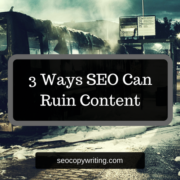What to Know About Local SEO: Interview with Andrew Shotland
 Steeped in Local SEO and search for some 13 years, Andrew Shotland is a leading expert in this highly competitive space. He is the proprietor of Local SEO Guide, an SEO and SEM consultancy (and blog) he founded nine years ago. Andrew has also authored Search Engine Land’s monthly local search column since 2009.
Steeped in Local SEO and search for some 13 years, Andrew Shotland is a leading expert in this highly competitive space. He is the proprietor of Local SEO Guide, an SEO and SEM consultancy (and blog) he founded nine years ago. Andrew has also authored Search Engine Land’s monthly local search column since 2009.
Before launching his own business, Andrew headed up business and product development for Insider Pages, a local search startup. As its Chief SEO Officer, he developed an SEO program that attracted over 3 million unique visitors/month to the site.
Here, Andrew answers questions about Local SEO best practices and search trends, as well as the challenges faced by brands competing on a local level. Enjoy!
Could you briefly summarize the essential ways that Local SEO differs from the SEO for big national brands?
Google, Bing & Yahoo typically show separate local business listings for queries they deem to have significant local intent. The methodologies to compete for rankings in these “local packs” are somewhat different than those you would apply to non-local SEO.
Local SEO also includes appearing well in local-specific search services such as Apple Maps, Facebook Local, Yelp, the Yellow Pages sites and various vertical search engines. It’s a huge, complex space to play in.
If you were to list Local SEO best practices, what would be the top 3? Why?
The Top 3 Local SEO Best Practices in no particular order:
- Compete for relevant queries where you have a physical location. It’s hard to show up in the local results without a physical location in the searched city.
- Make sure your Google My Business (GMB) and top local search site business profiles (e.g. Yelp, YP.com, etc.) are claimed, up to date and consistent with your N.A.P. (Name, Address & Phone Number) that appears in text on your website.
- Don’t ignore the non-Local pack results. These can generate significant traffic. So do all of the typical SEO things to your site to help it rank well: Ensure Googlebot accessibility, use smart keyword/content targeting and get links from other sites.
Last week, Mike Blumenthal (and other local SEO experts) reported that Google had dropped businesses’ G+ pages from its “Places” search results, instead returning URLs from its “Maps” API. Do you think this is just part of Google’s mobile agenda, or is it, as Blumenthal suggested, another indication of the impending “divorce” of local search from G+? What would you say are the implications?
I don’t think this is that big a deal. Google is trying to untangle all of its services from Google+. Google+ for businesses was pretty confusing so perhaps this might end up making Google My Business easier to deal with. I don’t think this changes how we approach Google Local at all. Perhaps this will screw up some services that relied on the API for data, but that’s about it.
In your monthly Search Engine Land (SEL) column, you frequently cite how a well-optimized Google My Business (GMB) page can boost local businesses’ rankings. What specific things would you recommend a Webmaster (or site owner) do to fully leverage their GMB page?
There are a few things you can do to leverage your GMB page:
- Make sure all of the info is up to date
- Make sure your business categorization is correct
- Make sure it links to the most relevant URL on your site (this one is huge)
(Editor’s note: You can view Andrew’s Local SEO Guide GMB page here)
What are some challenges brands face with Local SEO?
Multi-location brands have some of the biggest problems with Local SEO, but some of the biggest opportunities, too. On the problems side, dealing with the data issues involving tens, hundreds and even thousands of locations can be a huge task.
In particular, managing their Google My Business issues requires a lot of well-honed processes to do it at scale. Unfortunately you can’t just use a cookie-cutter approach because the problems you encounter change every day.
On the plus side, when you have scale, you can use that to your advantage once you get the basics right, in terms of content, links, etc. We typically see multi-location brands able to rank for their target queries en masse much easier than single locations, all things being equal.
Given all the Google updates to its Local SEO algo over the past two years that you recently summarized in your September SEL column, what do you see trending for Local SEO and search?
We think two big opportunities at the moment are Facebook Local and iOS Search/Apple Maps. Both of these local search systems are generating huge traffic right now but it seems like most of the Local SEO world is ignoring them. That’s great for our clients :)
Any parting words about Local SEO and/or Google’s local algo updates?
It’s a great business because it’s always changing and it’s one of the biggest markets there is. It’s very satisfying to be able to help both large and small businesses navigate their ways through this ridiculous stuff. Sometimes I have to laugh that this is what I do for a living. It’s certainly fun.
Connect with Andrew on Twitter, LinkedIn, and Google+
Want to read insider tips and actionable strategies I only publish in my newsletter? Sign up today! It’s free!






Andrew Shotland is one of the most effective seo expert that you should trust. That’s why I’ve been reading some of his blog because it really helps me a lot in my own marketing campaign as well. Thanks for sharing this interview. Personally, I enjoyed it and I really learned something very helpful from it.
Damon hi! Thanks so much for your positive feedback on this interview. Most of the credit goes to Andrew — he did the lion’s share of the work! p.s. you can follow him via Twitter at @localseoguide. Again, thanks for your thoughtful comment. :)
I’d be curious to know more about the extent to which the local listings are ranked by different factors to organic results generally. From what I’ve seen with my clients, where Google shows local listings on page 1, that list has been ranked in the same order as those websites have appeared in the main listing.
If Google is showing the same results in both the local packs and the non-local organic section of the SERP, then it’s likely that there are no non-GMB-linked sites (e.g. Yelp, YP.com, other sites that don’t represent a business with a physical location) that have the enough organic relevance (e.g. backlinks, content, etc.) to deserve to show up at the top of the organic SERP. So you just got the local pack listings ordered by “organic” strength, or something like that.
Sorry, I guess I need to be careful with my words to describe it properly. I didn’t mean to say that the local and non-local organic results are identical. Rather that what I’ve observed is that the sites that appear in the local list will appear in that list in the same order as they do in the non-local organic results, though these results are interspersed between a whole bunch of other sites that appear only in the non-local organic results as well. I’ve kinda wondered whether that means that the local results are ordered mainly by “organic strength” or if there are other ranking factors in how the local results are ordered that I’ve just not been exposed to in the SERPs that I’ve paid most attention to.